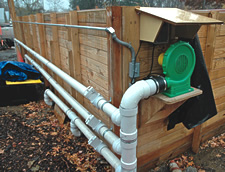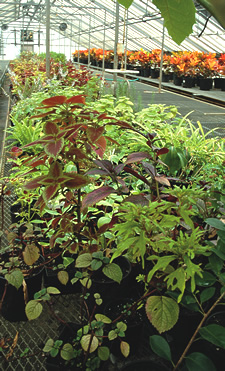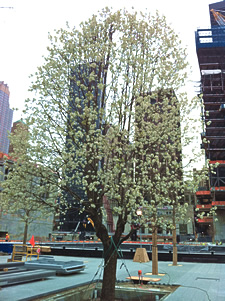
A successful two-year-old pilot composting project will be expanded to all five New York City boroughs.
Dan Sullivan
BioCycle December 2011, Vol. 52, No. 12, p. 31
For years the New York City Department of Parks & Recreation (Parks), in cooperation with the New York City Department of Sanitation (DSNY), had been composting leaves collected curbside and throughout the city in windows, mostly on park property in facilities managed by DSNY across all five boroughs. The DSNY launched a decentralized composting program in the early 1990s and in 1997 began collaborating with Parks on an expanded initiative in anticipation of the 2001 closure of Fresh Kills landfill. Curbside collection and DSNY’s involvement in leaf composting came to a halt with budget cuts in 2009 and is scheduled to resume in 2012.

The Department of Parks & Recreation launched a sustainable parks initiative in 2010, which includes expansion of a nearly two-year-old pilot composting project underway at the Parks Department Arthur Ross Citywide Nursery in the heart of Van Cortlandt Park in the Bronx. As a result of that success, each borough will install aerated static pile (ASP) technology designed by O2Compost Systems out of Snohomish, Washington. The units, to be constructed of marine-lacquered pine wood, consist of three side-by-side bins that are each 8 feet wide, 8 feet long and 4 feet deep; collectively, they take up a 24-foot by 8-foot footprint. Since each unit will require a flat, preferably hard surface, a source for electricity and access by equipment, the design of each will be adapted to its particular site.
Project leader and Citywide Nursery Director Richie Cabo and his crew propagate woody stems, woody shrubs, perennials and trees for mobile and stationary garden crews throughout the five boroughs. At Van Cortlandt Park, the nursery encompasses 4.5 acres that include 27 hoophouses, four poly houses and five greenhouses. It shares space with the Bronx Greenhouse and Mobile Horticulture Operation. Two other borough nurseries, on Staten Island and in Queens, will also serve as homes to the expanded composting pilot program. Finished compost will be used for horticulture and maintenance operations across all five boroughs. The nurseries will be “compost self-sufficient,” says Cabo, having the ability to produce more compost on a smaller footprint with a shorter retention time.

The composting recipe at Van Cortlandt Park includes a mixture of leaves, green waste and horse manure from nearby Riverdale Equestrian Stables and a cap of wood chips (in order to retain heat and to manage any potentially objectionable odors). While feedstock for the systems may vary somewhat across all five boroughs – as may the size of the units, depending on particular needs and resources – what it won’t include is food residuals.
“As an agency we don’t compost food products for public use,” says Ronnit Bendavid-Val, Parks director of Citywide Horticulture, explaining this is due to a mixture of logistics and other considerations. “The amount of work that we do to make sure the leaves don’t leave the ecosystem and can be incorporated back in is pretty significant.” Still, she says, there’s a shortage of the end product. “Generally speaking, there’s not enough compost for all the operations. We use more than we produce.”
According to Joseph Gobin, Bronx horticulture manager, the soil mix for new planting installations includes 25 percent compost by volume, once the resident soil has been turned over. Before the city’s decentralized composting program got underway, he says, that used to be provided by peat moss shipped in from Canada or beyond.

COMPOSTING OPERATIONS
The O2Compost System uses an electric blower to force air through a 4- or 6-inch HDPE perforated pipe (the borough systems will use 4-inch pipes) running at ground level along the length of the bin, pile or row. In the larger units, the pipes will be segmented so that sections can be moved, allowing easy access to the finished compost by a bucket loader. A timer turns the blower on intermittently (the original Citywide Nursery unit runs for 30 seconds every half hour) to regulate pile temperatures.
“The most important catalyst for running the pile hot enough is in the mix,” says Cabo. “In the case of Citywide’s system, we use the horse manure and bedding along with the green plant matter, including grass clippings, and leaves to amp up the microbial activity.” Dispersing the various materials throughout the bins is also critical, he adds. And partnering with a stable to turn what would otherwise be a waste product into a resource “is a classic example of good permaculture practices put to use in urban horticulture,” says Cabo.
NEXT HORIZON
In 2007, Mayor Michael R. Bloomberg released PlaNYC in order to create a greener, more sustainable New York City. The plan specifically addresses the need to better manage food waste. “Better management of food waste can save money and reduce the environmental cost of food disposal,” the plan states. “Food scraps make up 18 percent of New York City’s residential solid waste stream, and we estimate that food waste composes 11 percent of commercial solid waste not including construction and demolition fill. We will create additional opportunities to recover organic materials including food scraps, yellow grease and yard waste at community and commercial levels.”
One big challenge in meeting that goal is that the three closest commercial composters are 80 to 120 miles away. But the “additional opportunities to recover organic food scraps at a community level” could easily include more urban composting.
December 19, 2011 | General



 THE New York City Parks department’s Arthur Ross Citywide Nursery Director Richie Cabo was injured in the line of duty while working as a New York State corrections officer at a maximum-security prison. Feeling he was too young to remain on disability, Cabo found a job at Citywide Nursery, eventually working his way up to become director. Besides growing most of the woody plants destined for public spaces in New York City, he was largely responsible for nursing the 9/11 survivor tree, a Callery pear (Pyrus calleryana) scorched almost beyond recognition at Ground Zero, back to life following the terrorist attacks.
THE New York City Parks department’s Arthur Ross Citywide Nursery Director Richie Cabo was injured in the line of duty while working as a New York State corrections officer at a maximum-security prison. Feeling he was too young to remain on disability, Cabo found a job at Citywide Nursery, eventually working his way up to become director. Besides growing most of the woody plants destined for public spaces in New York City, he was largely responsible for nursing the 9/11 survivor tree, a Callery pear (Pyrus calleryana) scorched almost beyond recognition at Ground Zero, back to life following the terrorist attacks.






